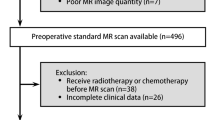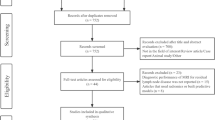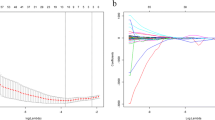Abstract
Objectives
To create a review of the existing literature on the radiomic approach in predicting the lymph node status of the axilla in breast cancer (BC).
Materials and methods
Two reviewers conducted the literature search on MEDLINE databases independently. Ten articles on the prediction of sentinel lymph node metastasis in breast cancer with a radiomic approach were selected. The study characteristics and results were reported. The quality of the methodology was evaluated according to the Radiomics Quality Score (RQS).
Results
All studies were retrospective in design and published between 2017 and 2020. The majority of studies used DCE-MRI sequences and two investigated only pre-contrast images. The sample size was lower than 200 patients for 7 studies. The pre-processing used software, feature extraction and selection methods and classifier development are heterogeneous and a standardization of results is not yet possible. The average RQS score was 11.1 (maximum possible value = 36). The criteria with the lowest scores were the type of study, validation, comparison with a gold standard, potential clinical utility, cost-effective analysis and open science data.
Conclusion
The field of radiomics is a diagnostic approach of relative recent development. The results in predicting axillary lymph node status are encouraging, but there are still weaknesses in the quality of studies that may limit the reproducibility of the results.
Similar content being viewed by others
References
Alvarez S, Añorbe E, Alcorta P et al (2006) Role of sonography in the diagnosis of axillary lymph node metastases in breast cancer: a systematic review. Am J Roentgenol 186(5):1342–1348
Antropova N, Huynh BQ, Giger ML (2017) A deep feature fusion methodology for breast cancer diagnosis demonstrated on three imaging modality datasets. Med Phys 44(10):5162–5171
Associazione Italiana di Oncologia Medica (AIOM) (2019) Istituto per la Ricerca sul Cancro. 2019. Linee guida: NEOPLASIE DELLA MAMMELLA. [online]. Available at: https://www.aiom.it/linee-guida-aiom-neoplasie-della-mammella-2019/. [Accessed 16 Aug 2020]
Balachandran VP, Gonen M, Smith JJ, DeMatteo RP (2015) Nomograms in oncology: more than meets the eye. Lancet Oncol 16(4):e173–e180
Baltzer PA, Dietzel M, Burmeister HP et al (2011) Application of MR mammography beyond local staging: is there a potential to accurately assess axillary lymph nodes? evaluation of an extended protocol in an initial prospective study. AJR Am J Roentgenol 196(5):W641–W647
Carter CL, Allen C, Henson DE (1989) Relation of tumor size, lymph node status, and survival in 24,740 breast cancer cases. Cancer 63(1):181–187
Caudle AS, Cupp JA, Kuerer HM (2014) Management of axillary disease. Surg Oncol Clin N Am 23(3):473–486
Chai R, Ma H, Xu M et al (2019) Differentiating axillary lymph node metastasis in invasive breast cancer patients: a comparison of radiomic signatures from multiparametric breast MR sequences. J Magn Reson Imaging 50(4):1125–1132
Cozzi L, Dinapoli N, Fogliata A et al (2017) Radiomics based analysis to predict local control and survival in hepatocellular carcinoma patients treated with volumetric modulated arc therapy. BMC Cancer 17(1):829
Cui X, Wang N, Zhao Y et al (2019) Preoperative prediction of axillary lymph node metastasis in breast cancer using radiomics features of DCE-MRI. Sci Rep 9(1):2240
Dong Y, Feng Q, Yang W et al (2018) Preoperative prediction of sentinel lymph node metastasis in breast cancer based on radiomics of T2-weighted fat-suppression and diffusion-weighted MRI. Eur Radiol 28(2):582–591
Fan M, Wu G, Cheng H, Zhang J, Shao G, Li L (2017a) Radiomic analysis of DCE-MRI for prediction of response to neoadjuvant chemotherapy in breast cancer patients. Eur J Radiol 94:140–147
Fan M, Li H, Wang S, Zheng B, Zhang J, Li L (2017b) Radiomic analysis reveals DCE-MRI features for prediction of molecular subtypes of breast cancer. PLoS ONE 12(2):e0171683
Ferlay J, Soerjomataram I, Dikshit R, Eser S, Mathers C, Rebelo M, Parkin DM, Forman D, Bray F (2012) Cancer incidence and mortality worldwide: sources, methods and major patterns in GLOBOCAN 2012. Int J Cancer 136(5):E359–86
Giuliano AE, Ballman KV, McCall L et al (2017) Effect of axillary dissection vs no axillary dissection on 10-year overall survival among women with invasive breast cancer and sentinel node metastasis: the ACOSOG Z0011 (Alliance) Randomized Clinical Trial. JAMA 318(10):918–926
Han L, Zhu Y, Liu Z et al (2019) Radiomic nomogram for prediction of axillary lymph node metastasis in breast cancer. Eur Radiol 29(7):3820–3829
Horvat N, Veeraraghavan H, Khan M et al (2018) MR imaging of rectal cancer: radiomics analysis to assess treatment response after neoadjuvant therapy. Radiology 287(3):833–843
Kuehn T, Bauerfeind I, Fehm T et al (2013) Sentinel-lymph-node biopsy in patients with breast cancer before and after neoadjuvant chemotherapy (SENTINA): a prospective, multicentre cohort study. Lancet Oncol 14(7):609–618
Lambin P, Rios-Velazquez E, Leijenaar R et al (2012) Radiomics: extracting more information from medical images using advanced feature analysis. Eur J Cancer 48(4):441–446
Lambin P, Leijenaar RTH, Deist TM et al (2017) Radiomics: the bridge between medical imaging and personalized medicine. Nat Rev Clin Oncol 14(12):749–762
Leithner D, Horvat JV, Marino MA et al (2019) Radiomic signatures with contrast-enhanced magnetic resonance imaging for the assessment of breast cancer receptor status and molecular subtypes: initial results. Breast Cancer Res 21(1):106
Li H, Zhu Y, Burnside E et al (2016) MR imaging radiomics signatures for predicting the risk of breast cancer recurrence as given by research versions of MammaPrint, Oncotype DX, and PAM50 Gene Assays. Radiology 281(2):382–391
Liang X, Yu J, Wen B, Xie J, Cai Q, Yang Q (2017) MRI and FDG-PET/CT based assessment of axillary lymph node metastasis in early breast cancer: a meta-analysis. Clin Radiol 72(4):295–301
Liu J, Sun D, Chen L et al (2019a) Radiomics analysis of dynamic contrast-enhanced magnetic resonance imaging for the prediction of sentinel lymph node metastasis in breast cancer. Front Oncol 9:980
Liu C, Ding J, Spuhler K et al (2019b) Preoperative prediction of sentinel lymph node metastasis in breast cancer by radiomic signatures from dynamic contrast-enhanced MRI. J Magn Reson Imaging 49(1):131–140
Liu M, Mao N, Ma H et al (2020) Pharmacokinetic parameters and radiomics model based on dynamic contrast enhanced MRI for the preoperative prediction of sentinel lymph node metastasis in breast cancer. Cancer Imaging 20(1):65
Lucci A, McCall LM, Beitsch PD et al (2007) Surgical complications associated with sentinel lymph node dissection (SLND) plus axillary lymph node dissection compared with SLND alone in the American College of Surgeons Oncology Group Trial Z0011. J Clin Oncol 25(24):3657–3663
Sacre RA (1986) Clinical evaluation of axillar lymph nodes compared to surgicaland pathological findings. Eur J Surg Oncol 12(2):169–173
Scheel JR, Kim E, Partridge SC et al (2018) MRI, clinical examination, and mammographyfor preoperative assessment of residual disease and pathologic completeresponse after neoadjuvant chemotherapy for breast cancer: ACRIN 6657 trial. AJR Am J Roentgenol 210(6):1376–1385
Shan YN, Xu W, Wang R et al (2020) A nomogram combined radiomics and kinetic curve pattern as imaging biomarker for detecting metastatic axillary lymph node in invasive breast cancer. Front Oncol 10:1463
Sun Y, Reynolds HM, Parameswaran B et al (2019) Multiparametric MRI and radiomics in prostate cancer: a review. Australas Phys Eng Sci Med 42(1):3–25
Surveillance, Epidemiology, and End Results Program (SEER) (2020) Cancer of the breast (female)—cancer stat facts. [online] Available at: https://seer.cancer.gov/statfacts/html/breast.html. [Accessed 19 Aug 2020]
Tan H, Gan F, Wu Y et al (2020) Preoperative prediction of axillary lymph node metastasis in breast carcinoma using radiomics features based on the fat-suppressed T2 sequence. Acad Radiol 27(9):1217–1225
Thawani R, McLane M, Beig N et al (2018) Radiomics and radiogenomics in lung cancer: a review for the clinician. Lung Cancer 115:34–41
Ye DM, Wang HT, Yu T (2020) The application of radiomics in breast MRI: a review. Technol Cancer Res Treat 19:1533033820916191. https://doi.org/10.1177/1533033820916191
Yu Y, Tan Y, Xie C et al (2020) Development and validation of a preoperative magnetic resonance imaging radiomics-based signature to predict axillary lymph node metastasis and disease-free survival in patients with early-stage breast cancer. JAMA Netw Open 3(12):e2028086
Funding
This study has not been funded.
Author information
Authors and Affiliations
Corresponding author
Ethics declarations
Conflict of interest
All authors declare that they have no conflict of interest. All authors submitted and take responsibility of this original manuscript. All authors affirm that all contents of this manuscripts has never been published or submitted for publications elsewhere. All authors approve the publication. All authors retain the copyright to the publisher. All authors refuse any financial, consultant, institutional and other relationships that might lead to bias or conflict of interest.
Ethical approval
All procedures performed in studies involving human participants were in accordance with the ethical standards of the institutional and national research committee and with the 1964 Helsinki Declaration and its later amendments or comparable ethical standards. This article does not contain any studies with animals performed by any of the authors.
Additional information
Publisher's Note
Springer Nature remains neutral with regard to jurisdictional claims in published maps and institutional affiliations.
Rights and permissions
About this article
Cite this article
Calabrese, A., Santucci, D., Landi, R. et al. Radiomics MRI for lymph node status prediction in breast cancer patients: the state of art. J Cancer Res Clin Oncol 147, 1587–1597 (2021). https://doi.org/10.1007/s00432-021-03606-6
Received:
Accepted:
Published:
Issue Date:
DOI: https://doi.org/10.1007/s00432-021-03606-6




